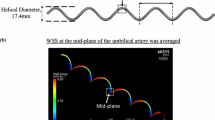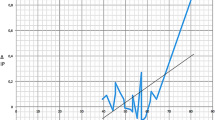Abstract
Artificial placenta (AP) is a promising approach to improve survival in extremely premature fetuses, removing them from the uterus and replacing the placenta by an external oxygenator. In in vivo experiments with lambs, haemodynamic changes were observed in the umbilical artery (UA) post-connection to the AP: decrease in flow pulsatility index (PI), increase in mean pressure and heart rate, and flatter diastolic flow with a secondary peak.
Computational models can help to understand the causes of observed phenomena. Therefore, the clinical objective of this work was to investigate the causes of the aforementioned changes in UA velocity, while the methodological objective was to implement a computational model capable of reproducing the behaviour of an AP.
We used a closed lumped model of the whole fetal circulation, modified to include the AP, and tested the haemodynamic changes in the UA after altering heart rate and AP’s resistance and compliance. We also added a simple wave reflection model and studied its effect on pressure and flow traces. We found that reducing AP’s resistance increased mean flow, and reducing compliance decreased velocity PI. When adding the reflection model, the flatter diastolic flow observed in the UA was reproduced.
This study suggests that the observed haemodynamics changes in the UA post-connection to the AP are due to a combination of decreased compliance and resistance, as well as wave reflections from components within the AP circuit.
Access this chapter
Tax calculation will be finalised at checkout
Purchases are for personal use only
Similar content being viewed by others
References
Preterm birth. https://www.who.int/news-room/fact-sheets/detail/preterm-birth
Bramwell, J.C., Hill, A.V.: The velocity of pulse wave in man. Proc. Roy. Soc. Lond. Ser. B, Containing Papers Biol. Charact. 93(652), 298–306 (1922). https://doi.org/10.1098/rspb.1922.0022, https://royalsocietypublishing.org/doi/10.1098/rspb.1922.0022
Bryner, B., et al.: An extracorporeal artificial placenta supports extremely premature lambs for 1 week. J. Pediat. Surg. 50(1), 44–49 (2015). https://doi.org/10.1016/j.jpedsurg.2014.10.028
Cahill, L.S., et al.: Wave reflections in the umbilical artery measured by Doppler ultrasound as a novel predictor of placental pathology. EBioMedicine 67, 103326 (2021). https://doi.org/10.1016/j.ebiom.2021.103326
Hill, A.A., Surat, D.R., Cobbold, R.S.C., Langille, B.L., Mo, L.Y.L., Adamson, S.L.: A wave transmission model of the umbilicoplacental circulation based on hemodynamic measurements in sheep. American Physiological Society (1995)
Howson, C.P., Kinney, M., McGougall, L., Lawn, J.: Born too soon : the global action report on preterm birth. Reproduct. Health, 9 (2013). https://doi.org/10.1186/1742-4755-10-S1-S1
Korteweg, D.J.: Ueber die Fortpflanzungsgeschwindigkeit des Schalles in elastischen Röhren. Annalen der Physik, 525–542 (1878). https://doi.org/10.1002/andp.18782411206
Miura, Y., et al.: Novel modification of an artificial placenta: pumpless arteriovenous extracorporeal life support in a premature lamb model. Pediat. Res. 72(5), 490–494 (2012). https://doi.org/10.1038/pr.2012.108
Myers, L.J., Capper, W.L.: A transmission line model of the human foetal circulatory system. Med. Eng. Phys. 24(4), 285–294 (2002). https://doi.org/10.1016/S1350-4533(02)00019-X
Ozawa, K., et al.: Fetal echocardiographic assessment of cardiovascular impact of prolonged support on EXTrauterine Environment for Neonatal Development (EXTEND) system. Ultrasound Obstet. Gynecol. 55(4), 516–522 (2020). https://doi.org/10.1002/uog.20295
Partridge, E.A., et al.: An extra-uterine system to physiologically support the extreme premature lamb. Nat. Commun. 8 (2017). https://doi.org/10.1038/ncomms15112
Patel, R.M., et al.: Causes and timing of death in extremely premature infants from 2000 through 2011. New Engl. J. Med. 372(4), 331–340 (2015). https://doi.org/10.1056/nejmoa1403489
Pennati, G., Fumero, R.: Scaling approach to study the changes through the gestation of human fetal cardiac and circulatory behaviors. Ann. Biomed. Eng. 28(4), 442–452 (2000). https://doi.org/10.1114/1.282
Pennati, G., Bellotti, M., Fumero, R.: Mathematical modelling of the human foetal cardiovascular system based on Doppler ultrasound data. Med. Eng. Phys. 19(4), 327–335 (1997). https://doi.org/10.1016/S1350-4533(97)84634-6
Saghian, R., et al.: Interpretation of wave reflections in the umbilical arterial segment of the feto-placental circulation: computational modeling of the feto-placental arterial tree. IEEE Trans. Biomed. Eng. 68, 3647–3658 (2021). https://doi.org/10.1109/TBME.2021.3082064
Shi, Y., Lawford, P., Hose, R.: Review of zero-d and 1-d models of blood flow in the cardiovascular system. BioMed. Eng. Online 10 (2011). https://doi.org/10.1186/1475-925X-10-33
Van Den Wijngaard, J.P., Westerhof, B.E., Faber, D.J., Ramsay, M.M., Westerhof, N., Van Gemert, M.J.: Abnormal arterial flows by a distributed model of the fetal circulation. Am. J. Physiol. - Regulat. Integrat. Comparat. Physiol. 291(5), 1222–1233 (2006). https://doi.org/10.1152/ajpregu.00212.2006
Weisstein, E.W.: Full Width at Half Maximum - from Wolfram MathWorld. https://mathworld.wolfram.com/FullWidthatHalfMaximum.html
Acknowledgements
The research leading to these results has received funding from "la Caixa" Banking Foundation. This work has been performed under FI 2022 grant number 00237, awarded by the Agency for Management of University and Research Grants (AGAUR), Generalitat de Catalunya.
Author information
Authors and Affiliations
Corresponding author
Editor information
Editors and Affiliations
Rights and permissions
Copyright information
© 2022 The Author(s), under exclusive license to Springer Nature Switzerland AG
About this paper
Cite this paper
Villanueva, M.I. et al. (2022). Haemodynamic Changes in the Fetal Circulation Post-connection to an Artificial Placenta: A Computational Modelling Study. In: Camara, O., et al. Statistical Atlases and Computational Models of the Heart. Regular and CMRxMotion Challenge Papers. STACOM 2022. Lecture Notes in Computer Science, vol 13593. Springer, Cham. https://doi.org/10.1007/978-3-031-23443-9_5
Download citation
DOI: https://doi.org/10.1007/978-3-031-23443-9_5
Published:
Publisher Name: Springer, Cham
Print ISBN: 978-3-031-23442-2
Online ISBN: 978-3-031-23443-9
eBook Packages: Computer ScienceComputer Science (R0)






